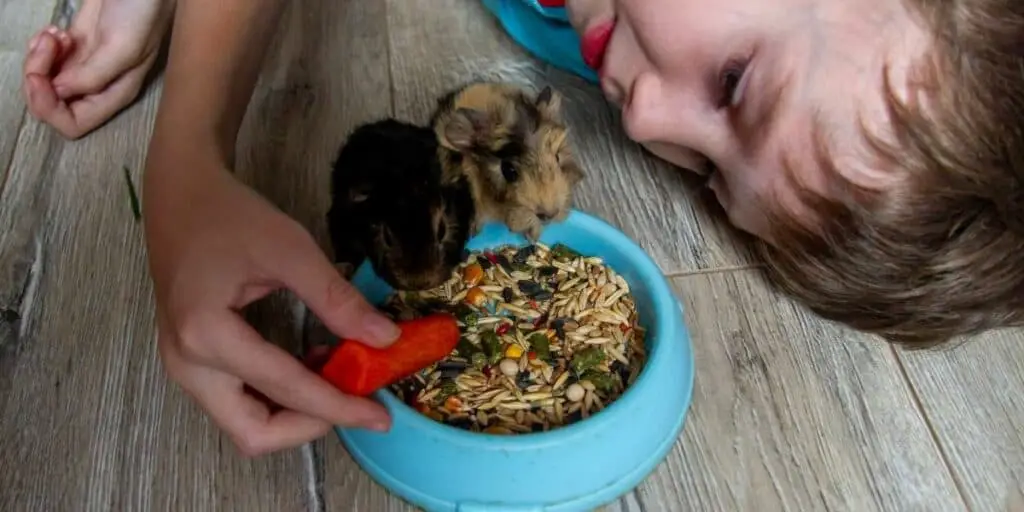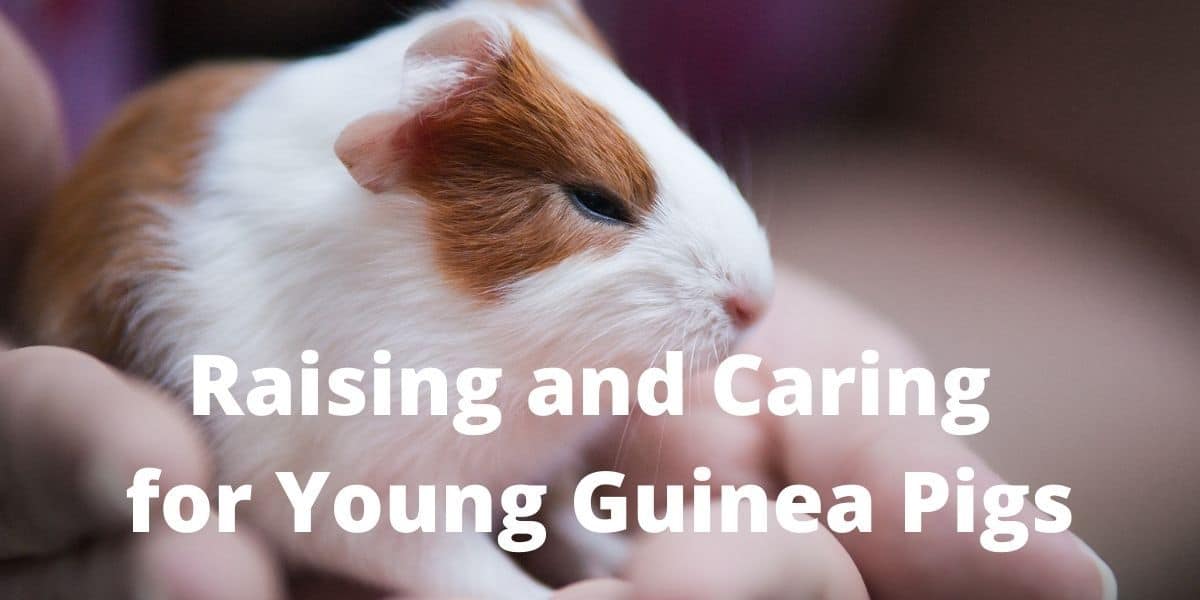You may have already been taking care of an adult guinea pig. That experience will come in handy, but you will need to learn to care for pups.
Just like you would care for human babies, you need to give special care and attention to the pups so that they not only survive but thrive.
Soon after they are born, if possible, you should leave them with their mother, who will naturally nurture them for some hours.
The mother will clean her pups and feed them after she has swallowed her placenta.
Here’s all you need to know about taking care of young Guinea Pigs.
Table of Contents
The Diet
A guinea pig will not begin to suckle from the mother immediately after birth; it may even take up to 24 hours before it begins.
They begin to eat solids three days after delivery, as their mother demonstrates to them how to.
However, this doesn’t mean it’s time to wean them.
Guinea pigs need milk to protect themselves from bacteria present in the alternative food sources introduced into their diet.
The staple diet of Guinea pigs is mainly grass hay. Feed them grass like timothy or orchard brome.
Don’t feed other hays and legumes to your baby guinea pig; even though they are herbivores, these foods’ calorie and protein content are too much.
However, you can feed alfalfa to nursing mothers as they need its high calcium levels.

Besides hay, guinea pigs also need some fresh fruits and vegetables to supplement their supply of vitamins. Half a cup per day will be sufficient.
Give your guinea pigs dark green leafy veggies rich in vitamin C.
Try to include lots of other vitamin C rich fruits for more variety, like apples and pears.
Include some pellets in limited quantities to your babies’ diet; these are not only a good source of nutrients but they are also good for the pups’ teeth.
Formula Feeding
Avoid force-feeding the baby guinea pig; if you are giving formula, be gentle and patient when introducing the bottle.
First, make sure the pup is steady, then offer the bottle or syringe of milk slowly.
Start by dropping a little milk on the mouth and allow it to lick until it begins to suck on its own.
Avoid accidental inhalation of milk or water by a pup as this could lead to pneumonia which can be fatal.
Weaning
After four weeks, the weaning process may begin, the mother will start to reduce the number of feeds per day from the 3 – 4 times that she is used to.
Suppose you are raising the pup without its mother and feeding it milk formula; you will need to start by diluting the milk with clean water, gradually increasing the proportion of water to milk until the pup loses interest.
Water
Clean water should be readily available at all times.
A sipper bottle that is easily accessible must be placed strategically in the cage to allow the pups to draw water comfortably.
Alternatively, you can put the drinking water in a heavy bowl that won’t turn over and spill.
Sheltering
Avoid wooden enclosures because guinea pigs can easily chew on wood, and it is also difficult to clean.
Instead, cages made of wire, glass, plastic, or stainless steel materials are preferable.
The enclosure must be big enough; a minimum of at least 8 square feet should be enough for a mother and her nursing pups.
Pups need enough space to explore and play around in their new environment.
These dwellings should also be well ventilated and escape-proof.
The cage must not have any sharp edges as these could lead to injury. We recommend the Prevue Cage from Amazon
Disinfect the habitat at least once a week, giving it time to dry before putting the pups back.
Most cages are made for adult guinea pigs, and the bars on the pen may be too wide, allowing the pups to squeeze through.
You can buy grids with much smaller spacing and secure them onto the cell, and these are available at your local pet store.
Alternatively, you can have a deeper pan on the floor, making it harder for the pups to climb out.
For the floor, solid flooring is preferable as it is safe for the pups though it requires more effort to manage.
Wire flooring is easier to maintain and keep clean, but it presents risks of injury to the pups.
They can hurt their feet and hocks or suffer broken legs if they fall through the wire and attempt to free themselves in panic mode.
Where to place the cage
The cage must be placed in a quiet place within your home because the guinea pigs can be sensitive to noise.
So at least during their first weeks of existence, the pups should be in a serene place.
Keep the enclosure away from direct sunlight, damp, cold and windy areas where these extreme weather conditions can negatively affect their well-being.
Bedding
The bedding typically consists of several inches of shredded newspaper or hardwood shavings.
This bedding must be changed at least twice a week to keep it clean, as it becomes wet with urine and water and gets soiled with droppings and leftover food.
Your baby guinea pigs need to be kept warm, two pups can cuddle together for warmth, but if it is one, you may need to place a warm water bottle wrapped in a soft towel inside the cage.
Do not use sawdust and cedar shavings because they pose some health hazards.
Handling your pup
Always wash your hands thoroughly before picking a pup to make sure you clean off any foreign smells from your hands.
You can rub your hands on the mother to get her scent onto your hands, so the pup feels more comfortable, or you can rub onto some fresh hay.
It’s advisable to slowly pick your pup from the front where it can see you. If it shows any signs of resistance, put it back in the cage gently and try again later.

You need to avoid handling your pup when it is sleeping or nursing as it will surely resist or get scared.
It may squeak or squirm to show its displeasure. Do not keep the pup away from its mother for too long because this will get it distressed.
Keep a firm but gentle grip on the pup so that it does not fall because a fall from a few feet high can lead to a severe injury to the baby guinea pig.
Guinea pigs are jumpy and quite unpredictable; therefore, handle them with caution.
You must begin handling your pup early so that it gets accustomed to human interaction. By so doing, they will be well socialised with people making them good pets.
Separation
Guinea pigs are friendly animals. They grow fast and will be independent sooner than you can imagine.
The more dominant guinea pigs may chew on the ears of their cage mates, so you need to be cautious.
The males are more difficult to keep together; brothers pair best.
To avoid early mating and pregnancy, males and females must be kept separately from 3-4 weeks of age. Sterilise the guinea pigs after 16 weeks.
After eight weeks, if the pup has been fully weaned and is eating solids well, it can be transferred to a new home.
A visit to the vet may be necessary to assure the pup’s readiness for a new home.
Entertainment
The baby guinea pigs will need toys to keep them busy; you can buy these at the pet store or simply use stuff that you can get from your houses, such as empty shoe boxes and tissue rolls.
They like to hide inside objects, only coming out when people are nearby.
Excretion
New-born pups will require stimulation to pass out urine and droppings.
The mother can provide the stimulation by licking the belly and genital area until the baby urinates.
You can use a cotton ball dipped in warm water to stimulate the abdomen and genital areas for 15 – 20 minutes in the mother’s absence.
When you feel the pup’s muscles contracting, it will be ready to excrete.
To conclude
Like all young babies, young guinea pigs need some tender loving care to thrive.
Be on the lookout for symptoms of ill health such as diarrhoea, overgrown teeth, poor appetite, ringworms and bleeding gums.
Visit a vet for treatment as soon as you notice any of these signs of ill health.
Enjoy nurturing your cute babies!





